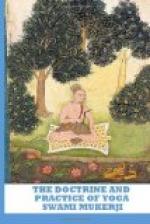Exercise IV.
(1) Place the hands on the hips, thumbs to the rear, and elbows pressed back; (2) bend the body forward, from the hips as far as you can, keeping the chest protruding and the shoulders pressed back; (3) raise the body to the original standing position (hands still at the hips) and then bend backward. In these movements the knees should not be bent and the motions should be made slowly and gently; (4) then (hands still on the hips) bend gently to the right, keeping the heels firmly on the ground, knees unbent and avoid twisting the body; (5) resume original position, and then bend the body gently to the left, observing the precautions given in the last movement. This exercise is somewhat fatiguing and you should be careful not to overdo it at the start. Proceed gradually; (6) with hands in same position on the hips, swing the upper part of the body around in a circle, from the waist-up, the head describing the largest circle, of course. Do not move the feet or bend the knees.
Exercise V.
(1) Standing erect, with hands on hips, raise yourself on the balls of the feet several times, with sort of a springing motion. Pause a moment after you have raised upon your toes, then let the heels sink to the floor, then repeat, as above suggested. Keep the knees unbent and the heels together. This exercise is specially beneficial in developing the calf of the leg, and will make it sure the first few times it is tried. If you have an undeveloped calf here is the exercises for you; (2) with hands still on hips place your feet about two feet apart, and then cover the body into a “squatting” position, pausing a moment and then resuming original position. Repeat several times, but not too often at the first, as it will make the thighs feel a little sore at the beginning. This exercise will give one well developed thighs. This last movement may be improved upon by sinking down with the weight resting upon the balls of the foot, instead of upon the heel.
Exercise VI.
(1) Stand erect with hands on hips; (2) keeping the knee straight, swing the right leg out about fifteen inches (keeping the toe turned a little out and the sole flat)—then swing back to the rear until the toe points straight to the ground, keeping the knee stiff all the time; (3) repeat the swinging backward and forward several times; (4) then do the same with the left leg; (5) with hands still on hips, raise the right leg up, bending the knee, until the upper-leg (thigh) stands straight out from the body (if you can raise it still higher, you may do so); (6) place your foot again on the ground, and go through the same motion with the left leg; (7) repeat several times, first one leg and then the other, moving slowly at first and gradually increasing your speed until you are executing a slow trot without moving from the over spot.
Exercise VII.




